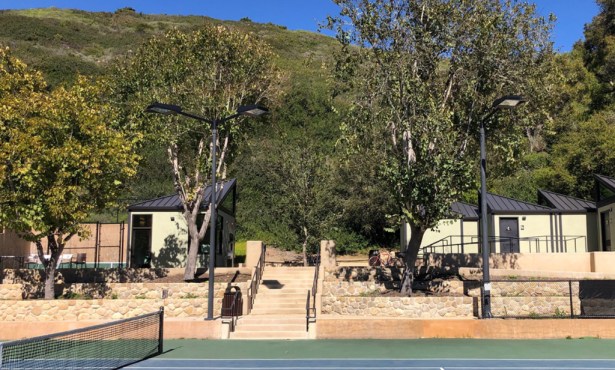Super, and Natural
The Unparalleled Carlos Santana Comes to the Bowl
by Josef Woodard
 Pop music keeps charging forward on its
Pop music keeps charging forward on its
playlisted, parallel tracks, and yet the remarkable and
unprecedented Santana saga continues. For close to four decades
now, Carlos Santana has led his eponymous Latin-rock band from
behind his well-worn and well-warmed electric guitar, hiring and
inviting guest vocalists to share the stage, but not so much the
spotlight.
He struck major radio gold early and now late (or is it
late-middle?) in his career, from the seminal early-’70s sounds of
“Black Magic Woman” and “Oye Como Va” to the staggering 1999
comeback sensation Supernatural, which gave him a vast new
audience, helped solidify the Latin pulse in pop again, and put
eight Grammys on his mantel. Late last year, Santana’s new album,
All That I Am, followed the template of
Supernatural, with guest cameos by the likes of Michelle
Branch, Mary J. Blige, Steve Tyler, will.i.am, and Los Lonely Boys.
Meanwhile, Santana keeps his hands in other musical worlds, playing
with jazz players Wayne Shorter and Herbie Hancock, whose album
Possibilities features a track with the soaring, signature
Santana guitar sound.
Over the decades, Santa Barbarans have had regular access to the
Santana sound, which always sounds fresher and tastier in the live
forum. When Santana returns to the Bowl for a two-night stint next
week, he’ll have a formidable history and songbook in tow, plus a
guitar sound with his name written all over it.
On the subject of keeping tabs on younger generations of
pop-music thinking, Santana, a lively interviewee, puts it thusly:
“Wet your finger, point it at the sky, and then the angels kiss it
and you hear the new music that is relevant with the pulse of the
times. I’m not interested in becoming a relic, getting caught in
the jukebox or the twilight zone of a certain era. It’s more
important to be in the fullness of the moment.”
One of your recent projects was a track on Herbie
Hancock’s album
Possibilities. You’ve worked with various vocalists and
integrated jazz and rock over the years. Did your own music offer
Herbie a template in a way? Well, hopefully, you and I can
break an egg and create a whole new vocabulary. See, the word
“jazz” to me is just like reggae or blues or hillbilly. It’s just a
word. Miles didn’t play jazz. He played “life” music. So if you and
I started calling it “life” music … they call it world music, which
tends to go to Bob Marley and myself. It’s really African music.
But if you call it “life” music, then you can integrate Ireland,
the Scottish, Norwegian, with African and Japanese and Mexican and
Apache, then you have “life” music.
World music, somehow, now goes to Bob Marley and Santana.
Actually, we both play African music. I invite you to start with me
a whole new genre of “life” music. It’s music from this planet.
I’ve been doing this thing for a long time.
If you have openness and he has willingness, you can reach
grandparents, parents, teenagers, and little children — and
Stravinsky and Miles and all the jazz snobs. But if you’re not
willing and open-minded, then you’re going to be a real
cookie-cutter type, someone with a low-ceiling existence.
You, along with Angélique Kidjo, do the song “Sofiatou”
on
Possibilities. How was that tune settled on? When this
project was mentioned to me, I sent eight songs, just moods and
songs that I had in mind. I did the same thing I did with John Lee
Hooker on The Healer. I rescued one of (Hooker’s) songs
that the Doors did, and gave it back to him. There was a song that
De-Phazz did, a song called “Let’s Get Together,” that sounded like
he copied what Herbie did, with “Watermelon Man” or “Maiden
Voyage.” But that was too close to him.
I brought him this other song from Mama Sissoko, an African
musician. That’s mainly what I listen to. We did that one and the
other song in one day. He settled for the guajira. As you
know, nothing drives women more crazy, sexually, than a
guajira. Supernatural has four or five songs,
guajiras, and that’s why the women went crazy for it. And
men bought the CD for the women.
By the grace of God, I know all of the African musicians, pretty
much. Out of 100, I know 99.9. I wanted to do this song on my own,
but I’m glad I did it with Herbie. They did a great job. It’s
beautiful to celebrate being alive, and that’s what that
guajira does.
You are an instrumentalist, by pure definition, yet
there is something about vocal music that allows access to a much
broader audience than instrumental music. What you’ve done works as
a balancing act, doesn’t it? Yes. You still need a song.
One thing I really learned from (Arista Records head) Clive Davis
is that you can be Horowitz, you can be Coltrane, but you still
need a song. You can be the most incredible improviser guy ever in
existence, but you still need a song — whether there’s a vocalist
or not. If you hear the melody of “Mona Lisa,” even without Nat
King Cole, the song is strong. Think of “Tequila,” from Wes
Montgomery. You don’t need to hear the vocal part.
I can sing a song. I’m a singer. So is Miles Davis. If I hear a
trumpet, sometimes I’m bored to death. When Miles plays a trumpet,
I don’t hear a trumpet. I hear life singing. It’s the same thing
with Wes Montgomery. And that’s the difference between a supreme
musician and a great musician. A supreme musician sings a song.
Everybody — Jewish, Japanese, Palestinians — they all claim it.
4•1•1 Santana performs at the Santa Barbara
Bowl, August 1 and 2, at 6:30 p.m., with Anthony Hamilton. Call
962-7411 or see sbbowl.com.


